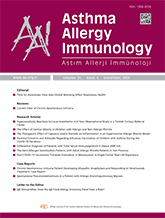


Objective: Allergic rhinitis is a common disease all over the world and allergy tests play an important role in the diagnostic process. Inhalant allergen susceptibility varies by region. We aimed to assess the distribution of aero-allergens in adult patients with allergic rhinitis in Van province.
Materials and Methods: We included 583 adult allergic rhinitis patients with compatible history, physical examination, and an allergy test. We evaluated the demographic features and allergy test results in addition to clinical and laboratory findings on patients with allergic rhinitis. The characteristics of the patients allocated into two groups with moderate/severe and mild allergic rhinitis were compared.
Results: Seventy-four percent of the patients were female and the median age of the patients was 29 years. The most common allergic comorbidities were allergic conjunctivitis (28%) and asthma (22%) while the non-allergic comorbidity was chronic rhinosinusitis (23%). The most frequent inhalant allergen sensitization was the grass mix (n=382, 65%), followed by cereal mix (n=308, 52%), dermatophagoides farinae (n=258, 44%), dermatophagoides pteronyssinus (n=256, 43%), english plantain (n=118, 20%), wall pellitory (n=54, 9%), olive tree (n=37, 6%), ragweed (n=21, 3%), birch (n=14, 2%), alternaria alternata (n=15, 2%), cat (n=13, 2%), aspergillus fumigatus (n=4, 0.6%), bird (n=3, 0.5%), and dog (n=1, 0.1%). Moderate/severe allergic rhinitis was associated with older age, longer disease duration and the presence of a family history of an allergic disease (p=0.003, p<0.001, p=0.004, respectively). Additionally, polysensitization was found to be higher in patients with moderate/severe allergic rhinitis while asthma and chronic rhinosinusitis were more common in patients with moderate/severe allergic rhinitis (p<0.001, p=0.009, p<0.001, respectively).
Conclusion: This study showed that pollen is the most common in the distribution of allergens in the sensitization of patients with adult allergic rhinitis in Van province. This study will guide physicians in the management of allergic rhinitis especially in terms of allergen immunotherapy.